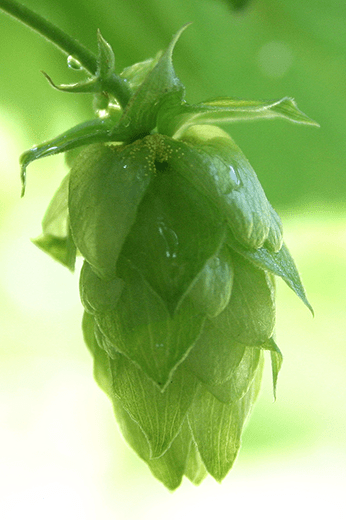 While malt is responsible for fermentable sugars and flavor, hops balance the sweet malt flavors with bitterness. Hops also contribute unique flavors and aromas to your homebrew. In some of America’s favorite beer styles (pale ale, IPA, and Double IPA), hops are the star of the show. The following terms are often used when discussing hops and the role they play in your homebrew beer:
While malt is responsible for fermentable sugars and flavor, hops balance the sweet malt flavors with bitterness. Hops also contribute unique flavors and aromas to your homebrew. In some of America’s favorite beer styles (pale ale, IPA, and Double IPA), hops are the star of the show. The following terms are often used when discussing hops and the role they play in your homebrew beer:
- Humulus lupulus – This is the botanical name for hops. Lupulus refers to the voracious, wolf-like speed at which hops grow.
- Bittering hops – Sometimes called early addition hops, bittering hops are added early in the boil and are responsible for most of the beer’s bitterness.
- Aroma hops – Aroma hops, also called finishing or late addition hops, contribute most of the flavors and aromas of the beer.
- Noble hops – Noble hops are a group of hops of European origin, prized for their aromatic qualities. Many old world beer styles use noble hops.
- Alpha acids – Alpha acids are the bittering resins in the hop flower. They must be boiled to extract their bitterness.
- Bracteole – On an individual hop flower, each “petal” is called a bracteole. Lupulin glands (see below) are located at the base of the bracteoles.

- Lupulin glands – Lupulin glands contain the alpha acids, resins, and essential oils that provide bitterness, flavor, and aroma.
- IBUs – IBUs, or International Bittering Units, are a measurement of a beer’s bitterness. IBUs are determined by the weight and alpha acid percentage of the hops being used, the length of time that they’re boiled, and the gravity of the wort in which they are boiled.
- Hop utilization – Hop utilization is a figure (a percentage or decimal) used to calculate IBUs. As boil time increases and wort gravity decreases, hop utilization increases. However, maximum hop utilization occurs after about 90-120 minutes of boiling.
- HBUs/AAUs – These abbreviations stand for Homebrew Bitterness Units and Alpha Acid Units; both mean the same thing. These units are an easy method for homebrewers to measure bitterness, but keep in mind that they are not the same as IBUs. To calculate HBUs/AAUs, multiply the weight of the hops in ounces by the alpha acid percentage of the hops. For example, a recipe calls for 1 oz. of hops with 4% AA (4 HBUs) to be boiled for 60 minutes. If you happen to have hops with 8% HBUs, you can use half an ounce of these hops in their place to get the same amount of bitterness (0.5 oz. * 8% = 4 HBUs)
- First wort hopping (FWH) – First wort hopping is an alternative method of extracting aroma from your hops. In FWH, hops are adding to the first runnings from the mash tun as the brewer collects wort for the boil, as opposed to being added at the end of the boil.
- Dry hopping – Dry hopping is another method for improving the aroma of your homebrew. Hops are simply added to the beer during secondary fermentation. Read these tips for dry hopping.
Are you a hop-head? What are some of your favorite hops?
————————————————————————————————————
David Ackley is a beer writer, brewer, and self-described “craft beer crusader.” He holds a General Certificate in Brewing from the Institute of Brewing and Distilling and is founder and editor of the Local Beer Blog.
